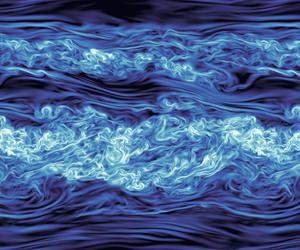当前位置:
X-MOL 学术
›
J. Fluid Mech.
›
论文详情
Our official English website, www.x-mol.net, welcomes your
feedback! (Note: you will need to create a separate account there.)
Mixing in forced stratified turbulence and its dependence on large-scale forcing
Journal of Fluid Mechanics ( IF 3.6 ) Pub Date : 2020-06-25 , DOI: 10.1017/jfm.2020.383 Christopher J. Howland , John R. Taylor , C. P. Caulfield
Journal of Fluid Mechanics ( IF 3.6 ) Pub Date : 2020-06-25 , DOI: 10.1017/jfm.2020.383 Christopher J. Howland , John R. Taylor , C. P. Caulfield

|
We study direct numerical simulations of turbulence arising from the interaction of an initial background shear, a linear background stratification and an external body force. In each simulation the turbulence produced is spatially intermittent, with dissipation rates varying over orders of magnitude in the vertical. We focus analysis on the statistically quasi-steady states achieved by applying large-scale body forcing to the domain, and compare flows forced by internal gravity waves with those forced by vertically uniform vortical modes. By considering the turbulent energy budgets for each simulation, we find that the injection of potential energy from the wave forcing permits a reversal in the sign of the mean buoyancy flux. This change in the sign of the buoyancy flux is associated with large, convective density overturnings, which in turn lead to more efficient mixing in the wave-forced simulations. The inhomogeneous dissipation in each simulation allows us to investigate localised correlations between the kinetic and potential energy dissipation rates. These correlations lead us to the conclusion that an appropriate definition of an instantaneous mixing efficiency, $\unicode[STIX]{x1D702}(t):=\unicode[STIX]{x1D712}/(\unicode[STIX]{x1D712}+\unicode[STIX]{x1D700})$ (where $\unicode[STIX]{x1D700}$ and $\unicode[STIX]{x1D712}$ are the volume-averaged turbulent viscous dissipation rate and fluctuation density variance destruction rate respectively) in the wave-forced cases is independent of an appropriately defined local turbulent Froude number, consistent with scalings proposed for low Froude number stratified turbulence.
中文翻译:

强迫分层湍流中的混合及其对大尺度强迫的依赖
我们研究了由初始背景剪切、线性背景分层和外力相互作用引起的湍流的直接数值模拟。在每个模拟中,产生的湍流在空间上是间歇性的,耗散率在垂直方向上有几个数量级的变化。我们重点分析了通过对域施加大尺度体力而获得的统计准稳态,并将内部重力波强迫的流动与垂直均匀涡模式强迫的流动进行了比较。通过考虑每个模拟的湍流能量预算,我们发现来自波浪强迫的势能注入允许平均浮力通量的符号反转。浮力通量符号的这种变化与大的对流密度翻转有关,这反过来又导致在波浪强迫模拟中更有效的混合。每个模拟中的非均匀耗散使我们能够研究动能和势能耗散率之间的局部相关性。这些相关性使我们得出结论,瞬时混合效率的适当定义 $\unicode[STIX]{x1D702}(t):=\unicode[STIX]{x1D712}/(\unicode[STIX]{x1D712}+ \unicode[STIX]{x1D700})$(其中 $\unicode[STIX]{x1D700}$ 和 $\unicode[STIX]{x1D712}$ 分别是体积平均湍流粘性耗散率和波动密度方差破坏率)在波浪强迫的情况下,独立于适当定义的局部湍流弗劳德数,与为低弗劳德数分层湍流提出的比例一致。
更新日期:2020-06-25
中文翻译:

强迫分层湍流中的混合及其对大尺度强迫的依赖
我们研究了由初始背景剪切、线性背景分层和外力相互作用引起的湍流的直接数值模拟。在每个模拟中,产生的湍流在空间上是间歇性的,耗散率在垂直方向上有几个数量级的变化。我们重点分析了通过对域施加大尺度体力而获得的统计准稳态,并将内部重力波强迫的流动与垂直均匀涡模式强迫的流动进行了比较。通过考虑每个模拟的湍流能量预算,我们发现来自波浪强迫的势能注入允许平均浮力通量的符号反转。浮力通量符号的这种变化与大的对流密度翻转有关,这反过来又导致在波浪强迫模拟中更有效的混合。每个模拟中的非均匀耗散使我们能够研究动能和势能耗散率之间的局部相关性。这些相关性使我们得出结论,瞬时混合效率的适当定义 $\unicode[STIX]{x1D702}(t):=\unicode[STIX]{x1D712}/(\unicode[STIX]{x1D712}+ \unicode[STIX]{x1D700})$(其中 $\unicode[STIX]{x1D700}$ 和 $\unicode[STIX]{x1D712}$ 分别是体积平均湍流粘性耗散率和波动密度方差破坏率)在波浪强迫的情况下,独立于适当定义的局部湍流弗劳德数,与为低弗劳德数分层湍流提出的比例一致。









































 京公网安备 11010802027423号
京公网安备 11010802027423号